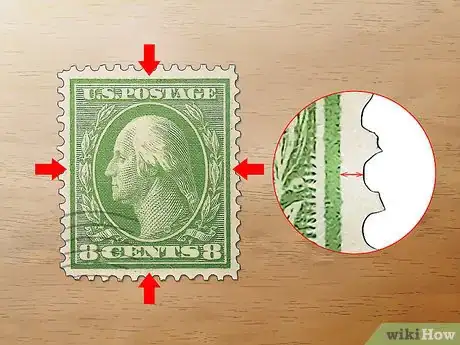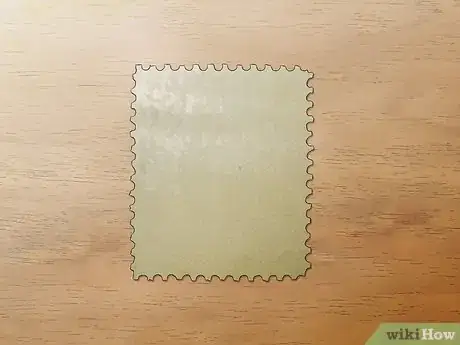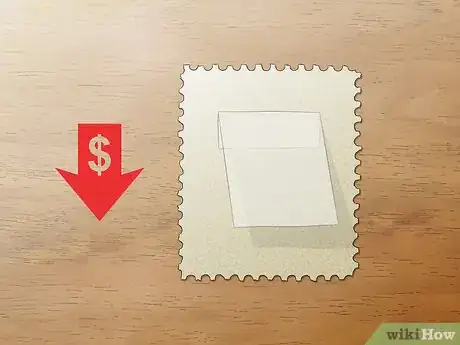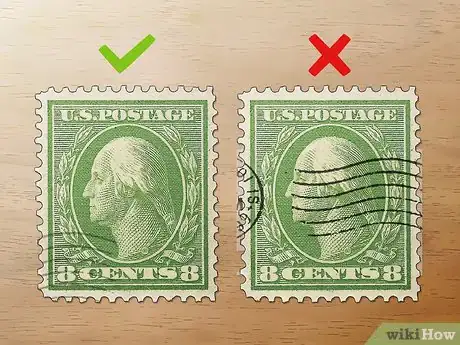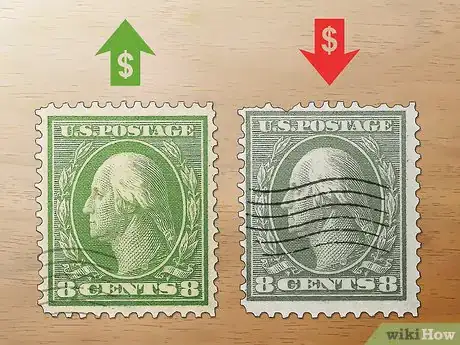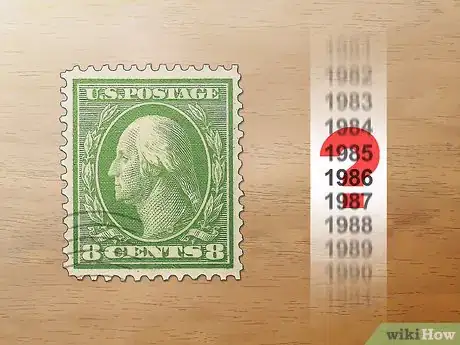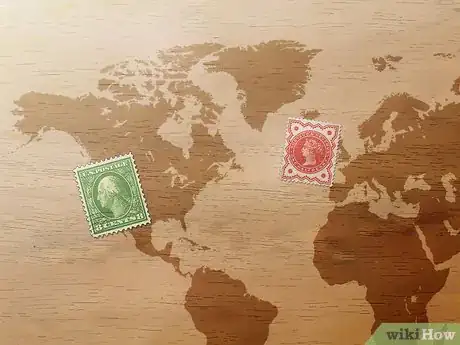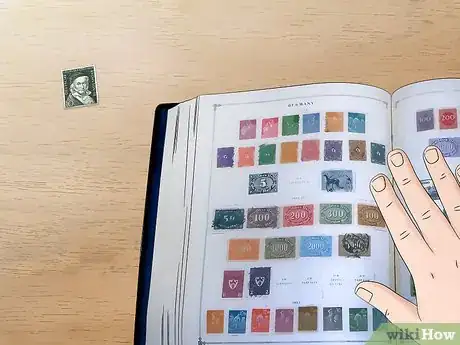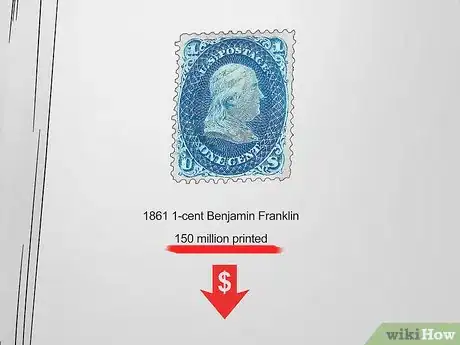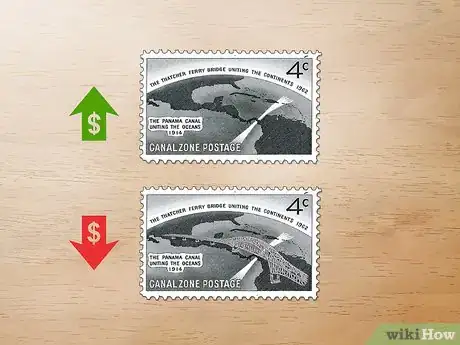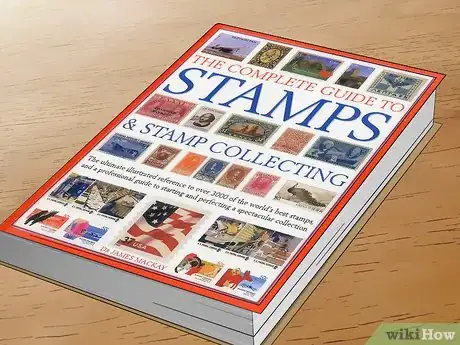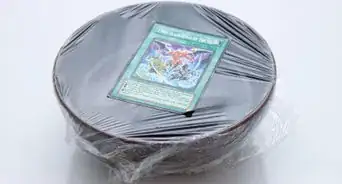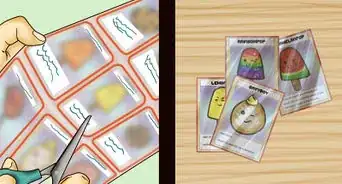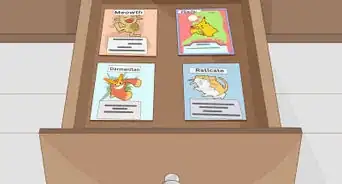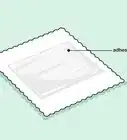This article was co-authored by wikiHow Staff. Our trained team of editors and researchers validate articles for accuracy and comprehensiveness. wikiHow's Content Management Team carefully monitors the work from our editorial staff to ensure that each article is backed by trusted research and meets our high quality standards.
There are 8 references cited in this article, which can be found at the bottom of the page.
wikiHow marks an article as reader-approved once it receives enough positive feedback. This article received 23 testimonials and 83% of readers who voted found it helpful, earning it our reader-approved status.
This article has been viewed 719,126 times.
Learn more...
Stamp collecting is a popular hobby all over the globe, and collectors enjoy everything from the aesthetic design aspects of the stamp to its rich history. Determining the monetary value of your stamps can help you appreciate them even more and know what prices to expect if you decide you’re ready to sell.
Steps
Observing the Physical Condition
-
1Judge the centering of the design. The more centered the stamp is inside the white perforation border, the better. You want the stamp to have an overall balanced, neat look.[1]
-
2Turn the stamp over and look at the gum. Stamp gum is the glue that sticks the stamp onto paper. You’ll want the gum to be as perfect as possible, with no skips or heavy creases.[2]Advertisement
-
3Check for a stamp hinge. A stamp hinge is a small, transparent piece of folded paper coated in mild adhesive, sometimes glued on the back of a stamp and used to attach it to an album page. A stamp hinge will make the stamp-less valuable, even after it’s been removed.[3]
- If your stamp has a stamp hinge attached, call a stamp dealer or expert before attempting to pull it off on your own, as you could damage the stamp further.
-
4Look at the neatness of the perforations. Perforations are the small holes punched along the edges of a stamp that help you peel it away from the sheet. Some stamps will have more perforations or larger circles, but what matters most is that they have full teeth and clean holes.[4]
-
5Look for a cancellation mark. If a stamp has been used, it will be stamped with a cancellation mark over the design. The heavier the cancellation mark, the lower the value of your stamp; you want to make sure it doesn’t blot or cover the stamp’s design.[5]
-
6Evaluate the stamp’s coloring. You want your stamp’s design to be bright and vibrant. Fading color can be caused by things like sunlight or artificial light, dirt, pollution, or skin oils.[6]
-
7Determine the stamp grade. Based on the centering of the stamp design and the heaviness of the cancellation mark, you’ll be able to get an idea of the stamp grade. There are a few possibilities for grade: poor, average, fine, very fine, and superb (mint condition).[7]
- Essentially, the worse the centering of the design and the heavier the cancellation mark on the stamp, the closer to a “poor” grade it will receive.
- Superb grades are quite rare, since the stamp must be perfect in all aspects.
-
8Leave the stamp on its envelope if it’s still attached. You don’t want to risk damaging the stamp by pulling it off or cutting it away. Sometimes an old, used stamp on an envelope with a special cancellation will have a higher value than the stamp would have unused and unattached. Ask an expert at a stamp show or get a professional appraisal to see if the stamp should be removed.[8]
Determining History and Rarity
-
1Figure out the age of the stamp. Easier said than done! You may be able to determine the age based on clues in the design. Look for historical events or figures, or try to pick out words on the stamp. Exact years are not typically printed on stamps, so it can be quite difficult figure out exactly how old your stamp is.[9]
- Head to an expert stamp dealer if you need extra help. The older the stamp is, the more valuable it will be--so it’s worth the extra effort!
- Stamps printed within the last 70 years, even those in mint condition, probably won’t be valued any higher than they were originally.[10]
-
2Determine the stamp’s country of origin. As with the stamp’s age, look for historical figures or events on the stamp, or words--knowing the language can help you narrow down the country.[11]
- A picture of Queen Victoria, for example, is probably from 19th-early 20th century Great Britain, while a picture of the Hoover Dam may be mid-century American.
-
3Identify the stamp with a reference book. Depending on your stamp, it might be easier to identify it before you try to determine the age and country of origin. After you’ve looked over the stamp’s physical condition, you’ll know enough about it to be able to find it in a reference book.
- American stamp collectors often use the Scott Specialized Catalogue (now available in an e-book format as well), while British philatelists tend to use the Stanley Gibbons catalogue. Check out your local library to see what options you have.
- You can try looking at online resources and catalogues as well, but do so with a grain of salt. They may not be as accredited or accurate as reference books.
-
4Determine the rarity of the stamp. The stamp’s rarity will depend on its age and quantity in its initial print run. The rarer the stamp, the higher the value; some stamp collectors even say that rarity is the single most important factor in determining stamp value, more than condition or age. Check in reference books or with a professional dealer to figure out the initial print run of your stamp.[12]
- An old stamp won’t necessarily be rare and valuable. The 1861 1-cent Benjamin Franklin stamps, for example, aren’t very valuable because about 150 million of them were produced.[13]
-
5Keep an eye out for error stamps. Though in general you want your stamp to be as perfect as possible, error stamps are an exception. These rare stamps have an error in the design rather than the centering, perforations, etc. Error stamps are extremely valuable because of their scarcity; there may only be 50 or 100 of them in existence.[14]
- Valuable stamp errors include design errors, such as a map showing the wrong border; an omission error, such as Thatcher Ferry bridge stamps in which the bridge itself was missing in the design; or an inversion, like the American Inverted Jenny stamps, which printed a biplane upside down.
Consulting the Stamp Experts
-
1Consult a stamp reference book or online resource to determine value. Now that you’ve identified the stamp and any flaws in its condition, head back to your stamp reference book to begin to understand its value. Look for special “price guides” to postage stamps, the newer the better.
- Stamp price guides may not be completely accurate, but you’ll start to get a rough idea of how much your stamp could be worth.
-
2Head to stamp shows. These stamp conventions take place all over the world, and provide a place for philatelists to buy, sell, and value their stamps. Stamp dealers often list shows on their websites, and you can check out sites for the American Philatelic Society (APS) or the American Stamp Dealers Association (ASDA) as well to find a show near you. Bring along your stamp and ask for a few different opinions.[15]
-
3Have a stamp expert appraise the stamp. In the US, you’ll want to look for a dealer who’s a member of the APS or the ASDA. Flip open your phonebook to the “Stamps for Collectors” section or search online to find a dealer in your area and call them up to ask what the cost will be for an appraisal. It shouldn’t take long, and this will give you the most accurate estimate of your stamp’s value.[16]
- To find a dealer in other countries, search online. Organizations like the APS, despite being an American group, often list dealers (as well as shows) in other countries as well, such as Canada and Great Britain.
Community Q&A
-
QuestionWhat is the value of the Liberty Bell stamp?
 wikiHow Staff EditorThis answer was written by one of our trained team of researchers who validated it for accuracy and comprehensiveness.
wikiHow Staff EditorThis answer was written by one of our trained team of researchers who validated it for accuracy and comprehensiveness.
Staff Answer wikiHow Staff EditorStaff AnswerThe forever Liberty Bell stamp is worth whatever the current standard-size letter stamp rate is, currently 0.55c in 2019. For earlier (vintage) Liberty Bell stamps, you’ll need to use a reference book to estimate its value, or talk to a stamp seller about the value.
wikiHow Staff EditorStaff AnswerThe forever Liberty Bell stamp is worth whatever the current standard-size letter stamp rate is, currently 0.55c in 2019. For earlier (vintage) Liberty Bell stamps, you’ll need to use a reference book to estimate its value, or talk to a stamp seller about the value. -
QuestionDo cancelled stamps have any value?
 wikiHow Staff EditorThis answer was written by one of our trained team of researchers who validated it for accuracy and comprehensiveness.
wikiHow Staff EditorThis answer was written by one of our trained team of researchers who validated it for accuracy and comprehensiveness.
Staff Answer wikiHow Staff EditorStaff AnswerCancelled stamps do have value but it is usually far less than stamps without cancellation marks on them. The value attached to a cancelled stamp will depend on the stamp’s rarity and desirability for collecting. Generally, the heavier the cancellation mark, the lower the stamp’s value and it will get a "poor" grade. However, if the stamp is rare or the cancellation mark is a special one, perhaps a commemorative or historic cancellation mark, then the stamp may still carry a high value. Many people begin stamp collecting only with cancelled stamps because they’re easy and cheap to obtain and a collection of such stamps can be just as beautiful as uncancelled ones.
wikiHow Staff EditorStaff AnswerCancelled stamps do have value but it is usually far less than stamps without cancellation marks on them. The value attached to a cancelled stamp will depend on the stamp’s rarity and desirability for collecting. Generally, the heavier the cancellation mark, the lower the stamp’s value and it will get a "poor" grade. However, if the stamp is rare or the cancellation mark is a special one, perhaps a commemorative or historic cancellation mark, then the stamp may still carry a high value. Many people begin stamp collecting only with cancelled stamps because they’re easy and cheap to obtain and a collection of such stamps can be just as beautiful as uncancelled ones. -
QuestionDo old stamps have value?
 wikiHow Staff EditorThis answer was written by one of our trained team of researchers who validated it for accuracy and comprehensiveness.
wikiHow Staff EditorThis answer was written by one of our trained team of researchers who validated it for accuracy and comprehensiveness.
Staff Answer wikiHow Staff EditorStaff AnswerMany old stamps have value based on their rarity, beauty and historical interest. Indeed, rare old stamps can be worth high amounts of money. This is from a collectible perspective. If you are asking whether an old stamp can still be used for postage, that depends on the currency stamped on it and the postal service’s rules on the use of older stamps. Just take care not to send a rare, valuable old stamp as modern postage!
wikiHow Staff EditorStaff AnswerMany old stamps have value based on their rarity, beauty and historical interest. Indeed, rare old stamps can be worth high amounts of money. This is from a collectible perspective. If you are asking whether an old stamp can still be used for postage, that depends on the currency stamped on it and the postal service’s rules on the use of older stamps. Just take care not to send a rare, valuable old stamp as modern postage!
References
- ↑ http://about.usps.com/publications/pub192/pub192_015.htm
- ↑ http://www.2-clicks-stamps.com/article/value-of-old-postage-stamps.html
- ↑ https://stampcollectingspot.com/hinged-vs-never-hinged-stamps
- ↑ http://www.2-clicks-stamps.com/article/value-of-old-postage-stamps.html
- ↑ http://www.2-clicks-stamps.com/article/value-of-old-postage-stamps.html
- ↑ http://about.usps.com/publications/pub192/pub192_015.htm
- ↑ http://www.2-clicks-stamps.com/article/postage-stamp-grading-and-condition.html
- ↑ http://about.usps.com/publications/pub192/pub192_015.htm
- ↑ http://www.stamp-collecting-resource.com/stamp-collecting-values.html
- ↑ http://www.stamp-collecting-resource.com/stamp-collecting-values.html
- ↑ http://www.stamp-collecting-resource.com/stamp-collecting-values.html
- ↑ http://www.2-clicks-stamps.com/article/value-of-old-postage-stamps.html
- ↑ http://www.stamp-collecting-resource.com/stamp-collecting-values.html
- ↑ http://www.2-clicks-stamps.com/article/types-of-error-stamps.html
- ↑ http://www.stampnewsnow.com/calendarevents.html
- ↑ http://www.inheritedstampcollection.com/chapter_18.htm
About This Article
The easiest way to determine the value of a stamp is to judge the design’s centering and the neatness of the stamp’s perforations. See if the colors are still vibrant, which increases the stamp’s value, and whether a cancellation mark interferes with the overall look, which decreases it. Use a reference book to determine your stamp’s age and, most importantly, its initial print run--your stamp is more valuable if there were fewer stamps printed in the original run. To consult an expert or find out if your stamp contains valuable errors, keep reading!
